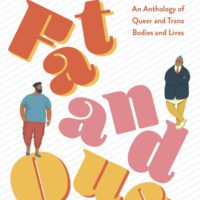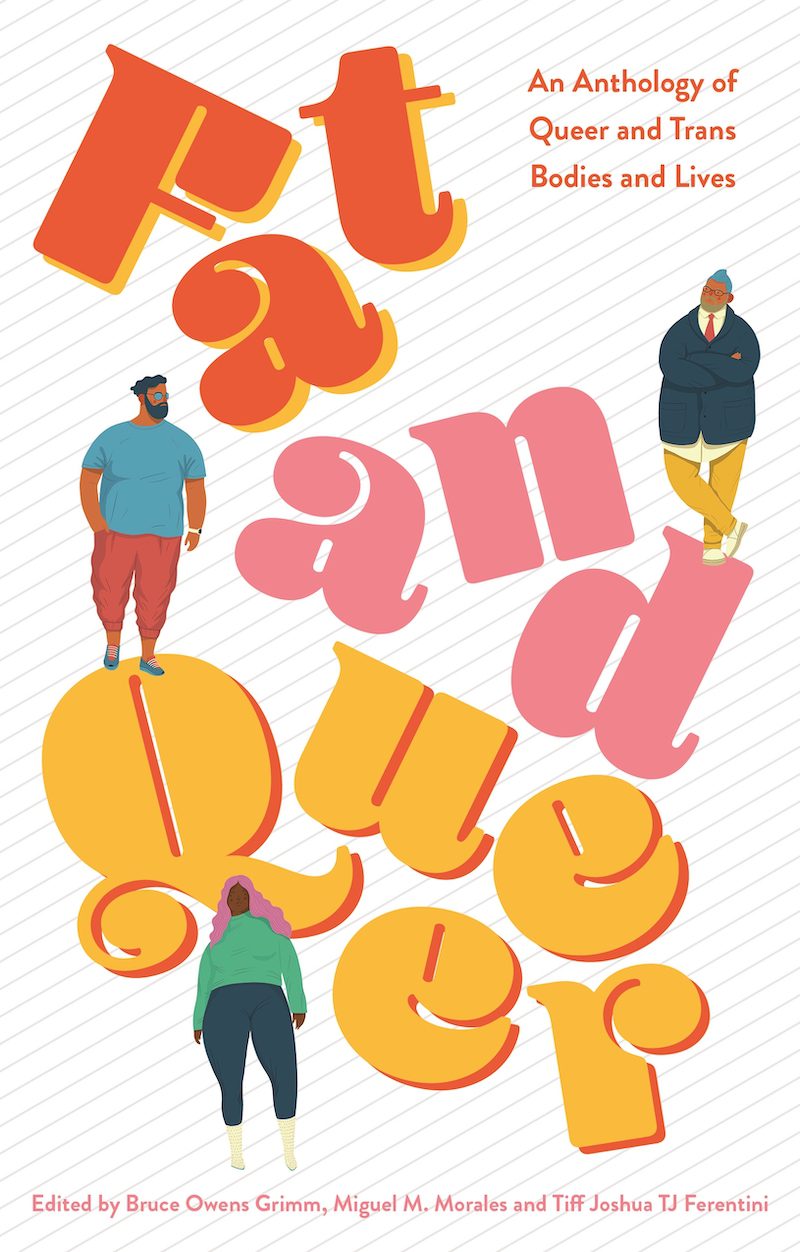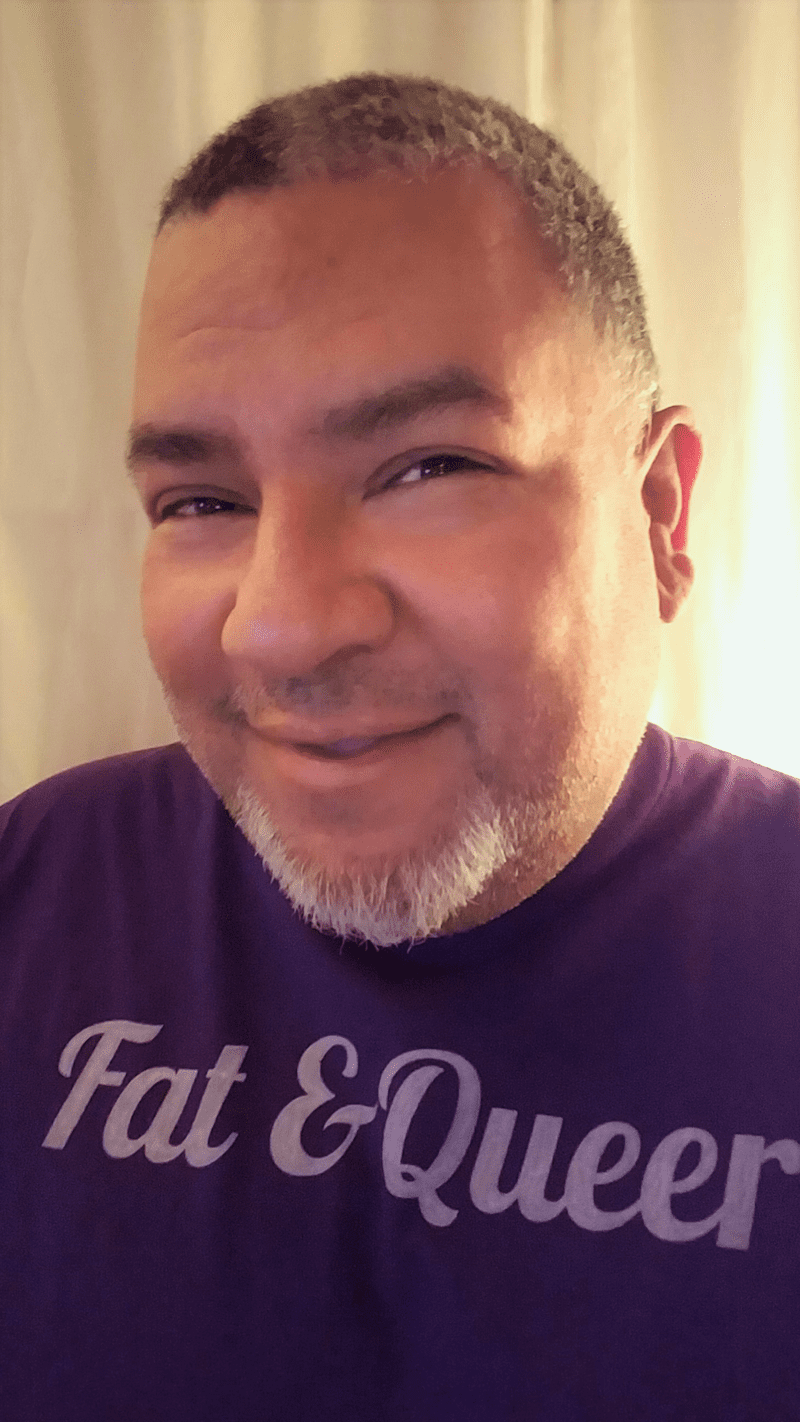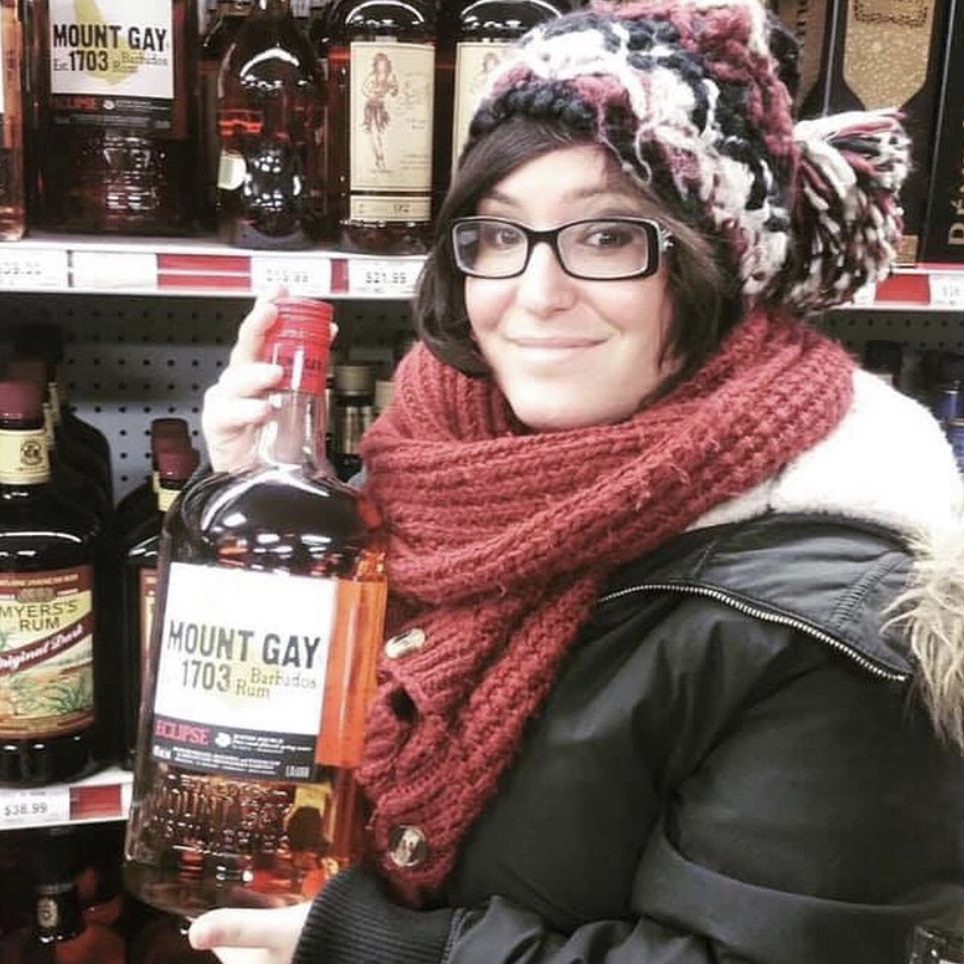“We’re here. We’re queer. We’re fat.”
This is the joyful, unapologetic chorus of voices in Fat and Queer: An Anthology of Queer and Trans Bodies and Lives edited by Bruce Owens Grimm, Miguel M. Morales, and Tiff Joshua TJ Ferentini. Curation and celebration, the poetry and prose in this text are also a reclamation—of space and story, of the right to exist in many forms. Reflecting on everything from the discrimination faced by fat, queer people and those who identify as BIPOC, to coming out later in life, to parental gatekeeping of weight and gender, to the roles fat and queer people played at Standing Rock, at Selma, at Stonewall and they roles they play to support BLM, to Stop Asian Hate, and to defend undocumented people today, the works in this anthology create the community many of the writers yearn for on the page. The reassertions echoed throughout this collection—freedom, pride, intersectionality—are enacted in the community built by the text itself, one that places established writers alongside those who are emerging, a collective dedicated to the legacy of queer elders that have paved the way and the queer youth who inspire the movement forward. As the editors say, “All are welcome to be part of the community, just bring some respect—and snacks.”
I recently had the pleasure of speaking with all three co-editors about curating Fat and Queer, and about finding and fostering fat and queer and fat and trans voices and stories.
***
The Rumpus: Bruce Owens Grimm, this anthology came about after your essay “Dropping Fictions and Gaining Visibility“ appeared in The Rumpus. Can you tell us more about the process of writing that essay and how it inspired this anthology?
Bruce Owens Grimm: Writing “Dropping Fictions and Gaining Visibility” scared me. As I say in my introduction to Fat and Queer, the gaining community is very secretive, which I understand to a certain degree because we live in a world where saying that you want to be fat, enjoy being fat feels very dangerous. However, for me, that secrecy became very oppressive. So when I saw the call for the (K)ink series at The Rumpus, I thought now or never. I pitched it to the series editor, Arielle Greenberg, in a very I have to send this in before I lose my nerve kind of way. Luckily, she was very generous, understanding, and really talked me through my worries.
After the essay came out, I had the chance to do a monthly essay series called Fat and Queer. I didn’t want to be the only voice in that series since experiences of fat vary so I invited Miguel to contribute to the series. Our original plan had been for the series to go on for much longer, but it didn’t for various reasons. Miguel then suggested doing an anthology to gather a multitude of fat and queer voices, and now here we are.
Bruce Owens Grimm
Rumpus: While this anthology contains many nonfiction accounts, it also includes poetry and hybrid texts. How did genre—resisting or remaking—and hybridity factor into the editorial vision for this anthology?
Grimm: Our main editorial vision for the anthology was that we wanted work that lived in the space of both fatness and queerness. Couldn’t be one or the other, had to be both. We didn’t want to be prescriptive about the form that exploration took, which is why we wanted to be open to all genres. Then we got these pieces that made magic with form and content while being in the fat and queer space. Personally, I’m interested in texts that push the boundaries of genre/form, which is why I’m so intrigued by bringing the ghost story into nonfiction through my haunted memoir work, so having pieces like that were super exciting, but that wasn’t a requirement or even an editorial guideline when reading submissions.
Tiff Joshua TJ Ferentini: When we first put out a call for submissions, we were expecting to receive mostly nonfiction and essay pieces. It was a pleasant surprise seeing the wide range of genres submitted to us, especially the number of poetry pieces we received! We never expected to receive so many poetry submissions, and these pieces in the anthology truly bring an added depth and strength to the anthology that really make it shine.
I also love how several of the pieces so cleverly play with the physical space and placement on the page, such as the font size of certain words, playing with line breaks to contribute to the overall shape or amount of space a piece takes up, or the fonts themselves used.
Rumpus: Miguel M. Morales, in your introduction to the text you write about an editorial process that fostered fat and queer writers through in-person and virtual meetings, writing prompts and sessions, social media signal boosting, and a sharing of community beyond the page. Can you say more about why this kind of editorial community was important to the project and why others might consider implementing these editorial practices?
Miguel M. Morales: When we first started reviewing submissions, some of those first pieces didn’t mention the word “fat” or even address fatness at all. For us it wasn’t enough for authors to identify as fat and queer or as fat and trans—their submissions had to address that experience. In order get those kinds of submissions, we did three things:
We extended our reach to find more voices that spoke about the intersectionalities of fat and queer and fat and trans experiences. People who are fat and queer or fat and trans already use social media to connect, to offer support, and to lift each other. Thankfully, all of the editors are active in that social space so we were able to easily slip into those newsfeeds and conversations that were already taking place.
We reexamined our request for original unpublished work because even though there was great interest in the anthology, we weren’t getting enough submissions. In addition, Carmen Machado’s piece was a reprint and we needed to acknowledge some of the work that had already been published while still holding space for emerging writers.
And finally, we realized finding fat and queer and fat and trans voices and writers wasn’t enough, we needed to foster them. We had to have a hand in helping create writers so that they could submit work to our anthology and to other places that welcome their voices. The best way to nurture them was to listen, to talk them through the process, to occupy space with them, and to ask questions of them and of ourselves. This process was important because some of the people we came across had never written before and of those who had, they’d never written about the intersection of queerness and fatness. While this step took more effort and energy (especially during the pandemic lockdown), we loved it. Working with the writers on their pieces allowed us to see where their voices would fit in the anthology and, hopefully, we made some friends.
Miguel M. Morales
Rumpus: Tiff Joshua TJ Ferentini, in your introduction to the anthology you write about the ways fat and queer folks intersect in a Venn diagram that labels both as “other.” How does this anthology claim space for stories so often “othered” or silenced altogether?
Ferentini: I think, for both fat and queer individuals, no matter how much progression is made in both communities, you can’t help but wonder about constantly being “othered,” about being rejected or seen a certain way, and whether you will truly be accepted for who you are: “Will my family and friends accept me when I come out to them?”; “Am I being judged for being the ‘fat’ person in this friend group?”; “Is this doctor going to meet me with fatphobia or transphobia?” etc.
I love how the pieces in this anthology not only take up the physical space of declaring, Yes, we are here and we exist, but also do so in such a way that they loudly, proudly, and unapologetically shout about what they are and who they are for.
Rumpus: Many of the texts in this anthology push against notions of gatekeeping in queer and literary communities. How do you see these pieces reflecting on and rewriting notions of gatekeeping?
Morales: This question makes me realize that every step of this process was a push back against gatekeeping. The fact that people submitted work, that we assembled editors, that we had the audacity to dream of the anthology—all of it is a push back. It pushes back on the idea that there’s an “acceptable” way to share stories about fatness, that as long as it’s traumatic and full of pain and regret, and occasional humor that specifically targets our own fatness, then our voices are heard, but only as cautionary tales. For me, the fact that this anthology exists is not just a push back against gatekeeping; it’s a middle finger to it.
Rumpus: Along those lines, you all have been very transparent about putting this anthology together, sharing everything from the proposal to the process. Why is transparency important to this project and how do your methods interrogate the larger world of publishing? What strategies might other editors and writers use to increase transparency and visibility in their work?
Grimm: There is so much secrecy surrounding publishing, especially if you don’t have an agent, and we were/are doing this unagented. A lot of writers make it seem like some magical process so we’d find ourselves having questions or difficulties at certain points in the process and thought we must be the only ones that go through this. We started keeping a list of these things, which led to the AWP panel we did this year about the process so we could help to start to demystify what goes into publishing a book.
Transparency is important in all projects because it’s one step in chipping away at the monolith of writing and publishing. I’ve been fortunate enough to have writers reach their hands out to me when I’ve needed it so hopefully this is one way I can do that for other writers who maybe need some way of knowing how to tackle such a project.
Morales: Transparency helps editors communicate, it helps contributors know where in the publishing process the manuscript is, it holds everyone accountable, it helps dispel conflict and misunderstandings, and it streamlines the entire process. Editors might think it’s an extra step that takes too much time but the reality is that it helps clarify your next steps and it moves things along so much easier than having to sort through chaos.
On a professional level, any publisher should welcome editors who are committed to communication and are honest about issues that arise. Transparency allows us to work out those issues quickly especially near the end of the publishing cycle when things move rapidly and the timeframe to address issues can be a matter of hours instead of a matter of days or weeks like it was in the beginning of the process. On a human level, we’re being trusted with people’s voices, their stories, we owe them transparency. Transparency is trust in action.
Rumpus: The list of contributors is impressive, including everyone from Carmen Maria Machado to Emilia Phillips to Roy G. Guzmán. How do you see these many voices working together? How did you go about selecting and arranging this chorus?
Grimm: I’m such a gigantic Carmen Maria Machado fan. She was my choice when we discussed our dream contributors. I saw her at AWP the year that we announced the anthology and started taking submissions. I told her about it and how much I’d love for her to be part of it. She so graciously said yes to us reprinting “The Trash Heap has Spoken.” I want to point out that she said yes before we even had a publisher. She was really the first one outside the three of us to believe in this book. Eternally grateful to her for that.
Morales: Roy G. Guzmán and I previously co-edited the anthology, Pulse/Pulso: In Remembrance of Orlando. I learned a lot about Roy’s heart, his respect for words, and his reverence for storytelling. I also learned from him that while sometimes those things appear to be at odds, if you’re patient and open, they’ll reveal a common path. He has always been supportive of this project so when we began to consider people who we wanted to write the forward, Roy was the perfect choice.
Ferentini: Originally, we had a combination of a list of writers we wanted to reach out to to invite to contribute to the anthology, as well as a number of individuals who seemed really excited about the project and wanted to submit. Ultimately, many of the writers we anticipated would submit to the anthology ended up not doing so—whether it be due to the pandemic posing as a hurdle, or due to the difficulty that comes with confronting one’s fatness and one’s queerness in such a raw and personal way. We were fortunate enough to have discovered many of the voices selected for this anthology through the submission process, and that passion and pride is palpable in each contributor’s individual piece. Every single piece was created with the mission of Fat and Queer in mind—the desire to claim the space and pride that comes with being both fat and queer, and how both are so integral to a fat, queer person’s identity—and there isn’t a single voice in the anthology that doesn’t want to or isn’t proud to be there.
Tiff Joshua TJ Ferentini
Rumpus: Finally, publishing and publicizing a book is always difficult, but even more so during a global pandemic. Can you speak to the challenges you faced in bringing this book into the world, as well as the surprising sources where you found community?
Grimm: The three of us all live in different cities so we would’ve always had online editorial meetings. Our submission deadline wasn’t very long after the pandemic first started so many writers we solicited and spoke to about submitting to the anthology didn’t have the mental space to work on new pieces. Totally understandable. I was in that same situation. I had a mental health crisis early in the pandemic making it difficult to work on the anthology at times. Luckily, I live in Chicago where services that helped me a lot are available to those without health insurance (I didn’t have insurance at the time).
In terms of publicizing the book, I love all the virtual events that are available now. They make it possible for all three of us to present at the events we currently have planned whereas before maybe only one or two of us would have been able to be there. I also love, love, love that the virtual events are accessible to those who may not have been able to attend an event in person. I really hope we keep virtual event components when in-person events come back.
Morales: I have friends whose books were published in early 2020. They planned book tours and set up wonderful events across the country. When the pandemic hit, they scrambled to find new ways to publicize their books. We’re fortunate those authors created new ways for writers to virtually tour and promote. But there’s still a feeling of loss. I really looked forward to bookstore readings and seeing others who look like me. I wanted to have conversations as we autographed books. I wanted to coordinate in-person events with our anthology’s contributors in my area. And while the vaccine will allow writers to begin returning to traditional marketing methods, the window for promoting a new book is very small. I guess that just means we all must work harder to extend that window.
As for surprises, I didn’t anticipate the friendships this anthology created. The extra time we took working with contributors coupled with the isolation of lockdown gave a greater weight (no pun intended) to our interactions. I’m excited to see where they’ll go and how their voices will grow this emerging genre.
Ferentini: I think one of the biggest challenges of working on this anthology in the middle of a pandemic was working through the emotional and mental burnout of not only living in a pandemic, but also digital burnout, and how that impeded upon and influenced both our ability to write and work as editors, as well as the writers who were submitting to the anthology. Another challenge, as I mentioned earlier, was finding writers who felt comfortable enough to not only talk about their fatness and queerness, but how the two of them intersected in such a way that resonated with what we envisioned for the anthology.
What was pleasantly surprising and refreshing was that the people who were passionate about this anthology were unapologetically passionate about it: this was evident in not only the pieces selected for the anthology, but in every single submission we received, follower we interacted with over social media, or writer that joined us when we hosted our virtual write-ins leading up to our submission deadlines.
Our goal with Fat and Queer was to find and connect members of this fat and queer community that we already knew existed, but nothing could have led me to anticipate that the bonds of that community would have been forged so strongly, and through each step of the publication process before the full anthology even came into fruition. I’m so thankful to Fat and Queer and to how its allowed me to connect with so many writers and contributors, and I can’t wait to continue the conversation with readers when they get to dive into the anthology themselves.
***
Photograph of Bruce Owens Grimm by Sara Wainscott. Photograph of Miguel M. Morales by Miguel M. Morales. Photograph of Tiff Joshua TJ Ferentini by Laurie Sheehy.








